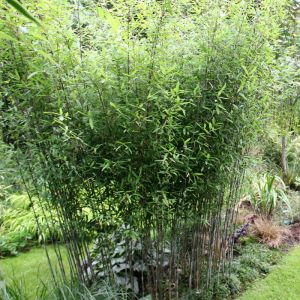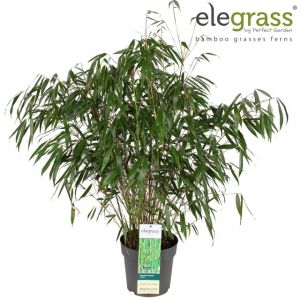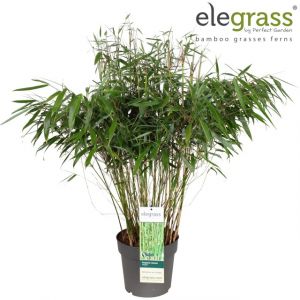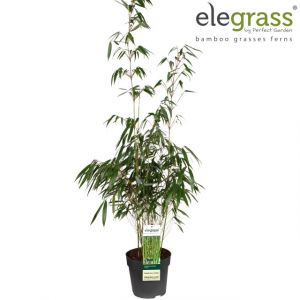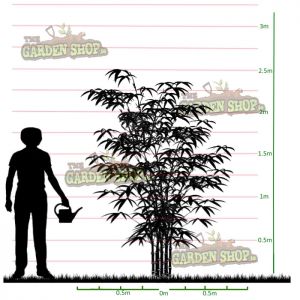![]()
Potted Bamboo Plant - Description
- Potted Bamboo Plants
- Fargesia Robusta 'Pingwu'
- Commonly Called 'The Fountain Bamboo'
- Popular Bamboo With Dark Purple/Green Canes
- Takes Approx. 3 Years For Dark Colour to Form
- Clump Forming Bamboo - Non Invasive
- Tall, Upright Bamboo Plant
- Mature Size: 2.5m
- Current Plant Size: 80cm
- Pot Size: 5 Litres
Potted Bamboo Plant - Characteristics
- Excellent stem details
- Strong upright growth
- Glossy green, narrow leaves
- Clump forming - Won't spread or become invasive
- Max spread: 1.5m
- These plants are happy in shade
- Foliage: Narrow, grass-like foliage, 15cm in length
- Final Height: 2.5m
- Evergreen bamboo plant
- Habit: Clump forming, tall Bamboo plant
- Spacing: 2m apart
- Grow rate: Fast
Potted Bamboo Plant - Care
- Happy in clay or loam soils
- Position in sun or shade
- Water well after planting
Potted Bamboo Plant - Uses
- Bamboo plants are great for screening
- Can be grown in pots
- Very popular for hedging & screening
- Plants are fast growing & evergreen
- Tall & narrow, is ideal against walls & boundaries
- Excellent specimen & architectural plant
- Suited to coastal areas
- Can be used as an informal hedge
- Bamboo companion plants include Acer Palmatum, Grasses, Kerria Japonica, Phormiums
Planting Large Garden Shrubs
Containerised garden shrubs can be planted any time of year, however the best time for any garden planting is between the months of September & March as this is the dormant season and the time when garden shrubs are not actively growing. The process of planting shrubs can start right back at the design phase when we choose the best plants for our garden.
Below is a quick guide on how to plant large shrubs to ensure they get the best start & give maximum results in the garden.
Planning
Planning your borders is an important process & it will ensure that you make the right choice when buying plants. When you plan your garden's planting layout, you should choose & position plants in the following order.
- Large & structural plants
- Architectural & focal point plants
- Medium & decorative plants
- Small & ground cover plants
- Infillers & herbaceous plants
Large plants are chosen & positioned first because these will form the structure & backbone to your flower beds. These large garden shrubs create the divisions, boundaries, privacy & year round form to your garden & borders.
As well as choosing these plants first at the design stage, these large shrubs are also positioned in the garden first. The position, shape & size of these plants will determine your decision making on all other plants that follow.
Once you are happy with the choice and position of your larger plants you can move on to planting & preparing your soil.
Preparing Your Soil
To ensure your plants settle in quickly & start growing as soon as possible, it is important to handle your plants carefully & provide your plants with the best soil & growing conditions. Your plants will need water, light, nutrients & space to grow and to ensure they get this you should improve your soil & allow sufficient space between plants.
Start by digging your planting hole. This hole should be roughly twice the width of the plant’s container & 1½ times its depth. Plant roots like to grow downwards, so to encourage this you can loosen up the soil in the base of the planting hole with a garden fork. If your soil is sandy, stony or very shallow then you will need to dig an even bigger hole & back fill with rich loam topsoil.
Once the hole is dug, add a small amount of john Innes No. 3 compost or add farm yard manure and mix it through the existing soil. At this point you can also add a small amount of fertiliser, for large plants you can add 70 grams of growmore plant food.
Planting
Handling your plants with care is very important. Your plants will already be experiencing the shock of being moved which will lead to a stunt in plant growth. So any additional stress caused to the plants at this point should be avoided.
If your plants are dried out, it is essential that you soak the root ball for 10 minutes before planting. To do this you can fill a bin or very large bucket with water and push the plant’s rootball & container down into the water. While the plant is soaking, you can prepare the planting hole as mentioned above.
Carefully lift the plant from its pot, gently ‘tickle’ the plant's root ball to free up the roots and encourage them to start growing outwards. Next, you need to determine the plant's best side and then position the plant in the hole.
Before back filling, ensure the plant is both level vertically & also level with the surrounding ground. It is very important to not plant a shrub too deep (will lead to stem rot) or too shallow (can lead to poor establishment & root ball drying out). Once you are happy you can back fill the soil & then press the soil in well with a strong tap of your foot.
Aftercare
The immediate after care of your plant is simply to water it in. Keep an eye on the plant for the first few months & make sure the soil never dries out. In very warm Summers you will need to water in new plants every 2 to 3 days.
If there are any bamboo canes or supports with the plants these need to be loosened now. Feed your plants every Spring & make mulch in Winter to keep your plant insulated & free from weeds.
Note: We don't ship plants on Fridays due to the extended period they would remain without light & water
Shipping Options & Rates
FOR IRELAND & NORTHERN IRELAND
- Standard Courier Delivery With An Post (3-4 Working Days)
- Cost is €4.95 on Orders Below €75
- Free Delivery on Orders Above €75
- Rep. of Ireland & Northern Ireland Only
- Express Courier Delivery With An Post (1-2 Working Days)
- Cost is €5 extra for express delivery
- This service guarantees that any order placed before 4pm will ship from our depot the same day on the next day delivery service *
- Rep. of Ireland & Northern Ireland Only
- Express Delivery With DPD (1-2 Working Days)
- Cost is €11.45 for orders below €75
- Cost is €6.50 for orders above €75
- This service guarantees that any order placed before 4pm will ship from our depot the same day on the next day delivery service *
- Rep. of Ireland & Northern Ireland Only
- This services comes with email tracking
- 'Seed' Postal Delivery Option ***
- Cost is €2 - Packet of Seeds ONLY Orders
- Note: Does Not Apply to Seed Potatoes, Bulbs or Sets ***
- Rep. of Ireland & Northern Ireland Only
- This is a non-trackable service
MAINLAND ENGLAND & SCOTLAND & WALES (Currently Unavailable Due to Brexit)
- Standard International Courier
- Cost is €10
- UK shipping fee covers parcels up to a total weight of 20Kg
WESTERN EUROPE & WORLDWIDE
- Standard International Courier
- Delivery rates vary, please see chart below
- Note: There is no free delivery for Western Europe Deliveries
Bulk Bags & Large Item Pallet Deliveries
- Bulk bags & large orders are shipped via pallet couriers on a rigid lorry
- Delivery is to kerbside only
- If road access to your site is tight, then please advise us before purchasing
- Please Note: We cannot guarantee next day delivery on pallet deliveries
- Also, we cannot guarantee delivery on a specific day (Please allow 1-3 days for delivery)
- It's always best to order well in advance to avoid disappointment
- Cancellation of pallets when items are already in transit will incur a 40 euro per pallet cancellation fee (To cover return delivery costs)
- Where pallet delivery can not be made due to site access, a 40 euro per pallet cancellation fee will apply (To cover return delivery costs)
International Delivery Prices & Times
- Please note max weights below, heavier orders may require additional payment
- We will contact you to discuss, if max weight of order exceeded
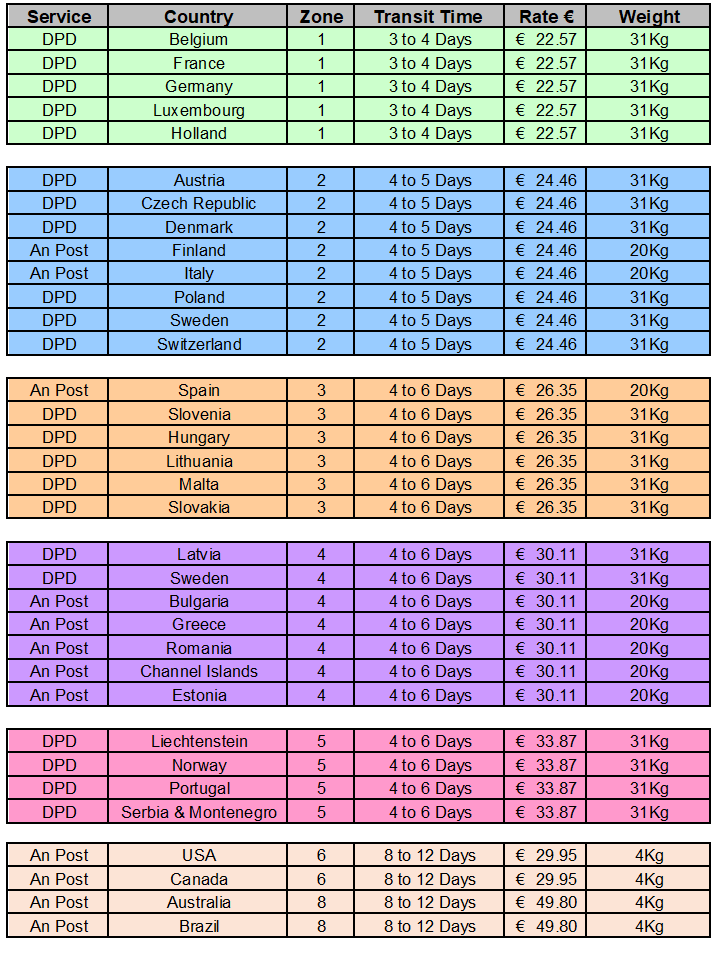
Terms
- The shipping fee is fixed for an order, regardless of the number of items bought
- All courier orders require signed proof of delivery & the customer must be contactable by phone
- We do not offer a weekend delivery service (Mon-Fri Only excl. Bank Holidays)
- * Our courier achieves a 98% success rate on next day deliveries
- Once your parcel is shipped it will be placed on works courier's next day delivery service
- ** Seed postal option applies to seed ONLY orders & is available in all 32 counties of Ireland
- *** Does not apply to seed potatoes, bulbs or sets

